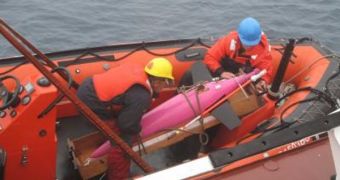Spending nine months and five days in the deep sea seems like something even a top-class submarine would find difficult to accomplish without maintenance work. But this proved to be a walk in the park for a University of Washington Seaglider, which spent this entire time on a single mission, roaming the Pacific Ocean, and submerging to great depths to collect scientific data. It roamed in total more than 3,050 miles (4,900 kilometers) in the North Pacific, a distance equivalent to crossing the Atlantic from England to the US. This achievement sets a new record for this type of craft and mission.
The ship's controllers say that no other underwater robotic exploration vehicles managed to stay on course within the parameters of such a mission, not even for half of the time the Seaglider did. The newly established record is absolute both in terms of the amount of time spent under the water, and of the total distance that the craft traveled under its own propulsion system (that is to say, unaided by currents).
“Operating endurance is about how far a glider propels itself – as opposed to drifting with currents – and how often dives are made to collect oceanographic data. And the Seaglider was truly autonomous the entire time,” UW Professor of Oceanography Charles Eriksen explains the accomplishment. The sleek and torpedo-shaped Seaglider-class watercraft was developed and constructed by a collaboration of experts from the university's School of Oceanography and the Applied Physics Laboratory.
In spite of spending more than nine months in the waters off the Gulf of Alaska, about 900 miles West of Vancouver, British Columbia, Canada, the craft showed minimal signs of biofouling. That is to say, very little algae, microorganisms and barnacles grew on it. In larger ships, these organisms are a real problem, as they decrease the speed, and significantly increase the fuel consumption, by increasing drag. The new record does not take into account the ten extra days that the Seaglider spent on the surface of the water, waiting to be picked up by rescuers.

 14 DAY TRIAL //
14 DAY TRIAL //